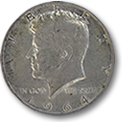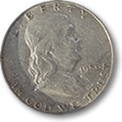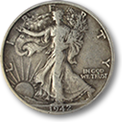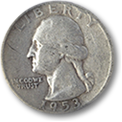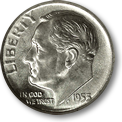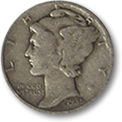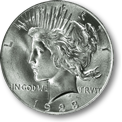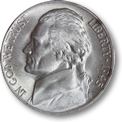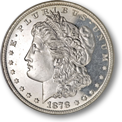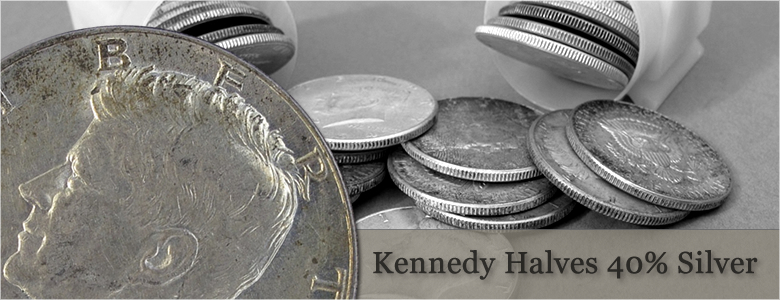
The History of Kennedy Halves - Forty Percent Silver
The Kennedy Half Dollars released in 1964 have one of the most unique histories of almost all the coins released from the US Treasury Mint Department. President John F. Kennedy was the very first "television" president. It was the first time in American history that the presidential family could be seen every night and this caused a major shift in emotional attachment to the man in office. This profound level of popularity had a long-lasting impact. This is also true for the Kennedy Half Dollar.On its first minting run, in 1964, the Kennedy Halves were 90 percent junk silver. To the public, this seemed very fitting. There had never been a coin commemoration for an assassinated president, and the emotions of the American public and the response to public opinion reflected a major event unfolding. Even though 236 million of these silver coins were struck, lines formed at banks that were so long people stood for several hours and the lines themselves interrupted normal business. People were paying twice their metal value, and in England they paid up to five dollars for a single silver Kennedy Half. There was no reasonable explanation for the massive hoarding by the common public. Many more of the 90 percent silver coins were scheduled to be minted.
The public, however, was caught in an emotional response to having witnessed a traumatic event and everyone seemed to want a silver half with Kennedy's image, and this caused a coin shortage. Some tried to blame this event on coin collectors, however it was not able to be substantiated. Many felt the obtaining of the Kennedy Half Dollar coin represented the best way common Americans could find closure and comfort after the shocking tragedy the nation witnessed live, on television.
The halves were only struck in the 90% silver for a short time. They were reduced to 40 percent silver as a result of the passing of the Coinage Act on July 23, 1965. From then on, all the Kennedy Halves were only 40 percent silver and this silver content would continue to be reduced until completely gone. 1965 saw the first release of the 40 percent silver halves. It was given no mint-mark that year in order to reduce the amount of hoarding that was happening to these coins, causing a shortage of half dollars in circulation. The missing mint-mark was done to deter collectors from hoarding, although it was an unfortunate missing of the mark on so many more levels than this one. The public really didn't care about that mint-mark. The public seemed to just want a valuable memory and a piece of his administration. It needed to be one that felt like a tangible possession worthy of a family legacy. These coins represented the ability to pass the coin down to grandchildren in a manner that would keep the Kennedy family a part of their own.
When the 40 percent silver halves were released in 1965, hoarding continued. Every time the Kennedy Half was released, it was hoarded out of circulation, causing a need to produce more coins due to the shortage of half dollars. More coins had to be produced to equal the need for coinage. A total of 295,046,978 of 40 percent junk silver coins were produced between Philadelphia and Denver Mint Departments and even though the copper-nickel metal values did equate in value at the time, silver was simply more popular. The 40 percent silver coins disappeared from circulation almost as quickly. The ratio of 40 percent silver was minted until 1970 when the metals changed to only copper-nickel combinations.
At the same time the silver in the Kennedy Halves was being reduced to 40 percent, the silver content from the dime and the nickel was being eliminated altogether. This only caused more problems. It made the 40 percent silver half the only coin with silver available, and this only worked to increase its perceived higher value. For the collector, however, this served to lower the value of the 40 percent half. Since there was no mint-mark, collectors had no way to tell which city or center actually minted them, and this caused the collectors of that time to almost ignore them.
The price of silver was on the rise. Actually, the price had risen so much people began to melt down the junk silver-containing coins. When the 40 percent silver coin was released in 1965, it had become the only silver coin in circulation. It was struck with no date as well, supposedly to discourage the collectors from hoarding them. In early 1980 the price of silver was up to $50 per ounce. The melting of these coins became common. The fact that they lacked a numismatic date only served to increase this activity. Without a mint-mark, they held little value to collectors, so the silver content was the primary value seen within this coin. Coin collectors and silver precious metals dealers termed them as junk silver coins.
Now that time has passed, it is possible to begin seeing and weighing the impact of the Kennedy half dollar dynamics. In 1998 the 1964 and 1964-D were valued at $3.50 per coin when in MS-65 condition. Today, however the value fluctuates wildly with the price of spot silver.
A similar pattern is seen in the coins that had no mint-mark dates. The coins with no dates were going for $2.25 to $2.50 apiece in 1998. A decade later, the 1965 coin was going for $18 the 1966 for about $14 and the 1967 could be found for $22. The only answer to the high value of the 1967 with such a high release number for that year was the lack of saving of the coin by collectors when the coin was first issued. The first release in 1964 saw 277,254,766 coins minted in Philadelphia and 156,205,446 in Denver.
By 1968 the mint-marks were returned to the Kennedy Half Dollar. The only real novelty to the coin was the obverse mint-mark which hadn't been placed on that side since 1917. This sadly wasn't enough to attract the collectors of the day. Collectors knew that the unusually large circulation releases with almost 250 million of them released at one time as was true for the 1968-D, and was a sign of its limited future as a special collector's item.
The 1968-D, virtually untouched by collectors yet profoundly hot as a public hoarding item was valued at only $2 in 1998. Today it will easily sell for $18. Speculators should be forewarned. History often repeats itself. Proof sets of 1968-S halves, not unlike the dime and quarter, also from San Francisco, fared a bit better in the markets than the circulation coins. At the time collectors really didn't know what to make of the proof sets. Numismatic histories tell a story about collectors who obviously felt the halves were practically worthless as an investment and apparently they were also confused about how to view the value of the proof sets.
From 1975 all denominations of proof sets came from San Francisco. It is difficult to obtain a single proof-only half for any specific date because most of the available coins are already in valuable complete sets. This has only served to drive up the individual value.
An example is the 1995-S that jumped from $13 in Proof-65 in 1998 to $35 today. The 1997-S increased its value from $13 to $34. Dramatically swinging price increases have become common for the Kennedy Half. At one point, the 1970-D was announced to be only available in mint sets for the year. The ordering time frame had passed by the time the public announcement was made. This meant only 2,150,000 examples of 1970-D would be available, and speculation soared. Recently this same coin seems to have stabilized following its 1998 swing from $13.50 to $50 for the MS-65.
In 1976 the Bicentennial Kennedy Half reverse featured Seth Huntington Independence Hall and came to be known as an exception. The bicentennial reverses for the quarter, half dollar and dollar turned out to be very popular with the public. Despite the shortages they have held up well and some have increased in value.
The original Kennedy Half design was returned to the coin in 1977. The habit of overlooking new dates seemed to have an impact as well and caused the mintage numbers to drop. The government began to market the commemorative coins in 1982, bullion coins were introduced in 1986 and other sets such as the silver proofs of 1992 seemed to attract the public more than the idea of continuing to save un-circulated half dollar rolls. This trend led to today's lack of Kennedy Halves. This, of course, led to the 1986-P jumping to $25. The 1990-P and the 1990-D were each $1.50 in MS-65 condition in 1998. Today they can be found for $18 and $15. Some of the other dates can go for around $10.
The story of the Kennedy Halves 40 percent silver coins is a lesson in far more than speculation mistakes. It shows how directly public sentiments can affect the markets, how long it can take to discover the truth under the most vibrant of assumptions. It shows how coin release under-currents, dating omissions and obverse changes can shift a market value. But most of all it shows us the immense impact that publicly witnessing tragedy and heart ache can have on the behavior and attitude about commemoration coins for ordinary Americans.








